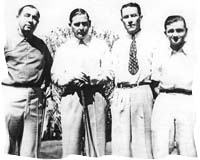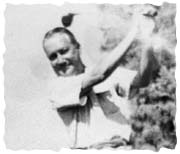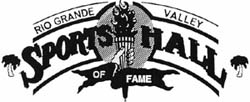Tony Butler
In an interview conducted with Harvey Penick regarding the men of the old
Texas PGA Section, the legendary Austin teacher had this to say about Tony Butler.
"He was one of my first students because his family lived next
door to mine. We were both just kids and we would hit shots in my parents' backyard.
Tony turned out to be one of the finest putters that I ever saw."
Ironically, the two shared another bond. Neither was a long hitter and both longed
to be.
Tony Butler, and the course re-named in his honor in Harlingen, are
both products of a time with which today's golfers are unfamiliar. They developed
during the game's rough-and-ready period -- before computer-generated course architecture
and swing analyzers and tigers that play golf.
It wasn't necessarily a better time. Or was it?

Butler (third from Left) appears at the Rio
Grande
Valley Pro-Am with Walter Hagen, Joe Kirkwood
and Dick Turner.
Born in Ganado on April 19,
1908, Tony Butler died at the age of 71 on December 9, 1979, following a 49 year career in
golf. The obituary published by Harlingen's Valley Morning Star hits the high points
of the man's golf career yet missed by a mile the point of his life.
The story reads, "He operated a pro shop and played golf
with many of his thousands of students." The obit further points out that
Butler might be called, "King of the Short-Knocks," and that he had a way of
making a 4-wood sing for its supper. All of which is true; none of which conveys
even half of the story.
Tony Butler was most definitely a legend with a 4-wood and he
proved it every now and then by playing entire rounds of golf using only that club.
He was also a fellow who played alongside great professionals such as Gene Sarazen, Walter
Hagen, and Dick Metz and had tea and crumpets with amateurs like Curtis Person.
Tony Butler turned professional in 1928, shortly after he entered the
University of Texas. The year before as a 20-year old, he had defeated Tinsley
Penick, Hervey's brother, in the Austin City Championship and had captained the Austin
High School golf team before that. Butler's college career lasted only briefly since
he left Austin and moved to Port Arthur as professional. Later, he returned to the
University of Texas as a student-coach and was the first person to hold a golf coaching
position at that school.
In 1931, Butler won the Texas PGA title by shooting seven under
par on the last 10 holes to beat Dick Metz by one shot. He earned a trip to the PGA
Championship in Providence, RI and was the only Texas representative to make the cut to
match play. Denny Shute, who went to the finals that year, sent Butler home in round
one but only after the Texan had carried the former British Open champion to the
38th hole.
In all, Butler finished in the money six straight times in 1931.
The next year, Butler followed up by finishing second when the Texas PGA Championship was
played at what was the Harlingen CC.
In 1934, Tony traveled to the British Colonial Open at Nassauk, The
Bahamas, where he finished second to the 1927 leading money winner Bobby Cruickshank by a
single shot.
In between all the tournament excitement, Tony Butler did what all club
professionals do: he took care of this family, gave lessons, and tried to earn a
living in a profession what was only totally unforgiving during and shortly after the
Depression.
As a teacher, Butler's method and philosophy appears simple by today's
standards. He once told a reporter that "there was nothing mysterious about
hitting a golf ball where you aim it." He said, "If a beginner really
wants to play golf, is willing to practice and isn't easily discouraged, there's no
reason why he shouldn't become a pretty fair player within a short time."
Butler was no Superman, it should be pointed out. He was tall,
thin, with small hands and slender arms . . . average. And the fact that he was
everyman, seems to have endeared him to the thousands he came in contact with in San
Angelo, Wichita Falls, Orange, Corpus Christi, Harlingen in 1933, then Beeville, and
Harlingen once again.
Butler's love affair with the Valley began during the summer of 1927,
when he accepted a summer position at Corpus Christi. In 1933, he defeated the
reigning National Open champion Gene Sarazen in an exhibition match staged at the old
country club on Upriver Road.
Shortly thereafter, Butler was contacted by Harlingen CC about a
position he kept until 1937.
Harlingen CC opened in 1929 and was originally a 9-hole layout designed
and built by John Bredemus. Bredemus was a foreward-thinking genius and that just
may have been one reason he designed a golf course in a sleepy little village that at the
time had a resident population of well under 25,000 and no northern snowbirds in the
pipeline.
Almost immediately it seemed, Harlingen was hosting the Rio Grande
Valley Open, and later, the "Life Begins at Forty" tournament. Harlingen
CC was certainly not a long course by today's standards. However, it required
strategic thinking as all Bredemus layouts do. And it had nasty, prickly rough to
the left #1 fairway that drove sane men crazy.
According to 1926 Texas PGA champion on Edwin "Beetle" Juelg
who was in attendance that fateful day in February when the opening exhibition round was
played, no less a luminary than Walter Hagen was brought to heel by the little course.
The story is that when Hagen hooked his tee shot off #1, he was forced to play back
to the teeing ground on his second because the rough would not allow him to go at the
green.
The second hole was a par 3 over a ravine and #3 was a par four with
water left and the main artery from Canada to Mexico on the right.
Tony Butler eventually left Harlingen CC to take another position, and
the Valley lost its position of the Tour to events in bigger markets.
Butler, however, was urged back to Harlingen by a petition signed by
several hundred area golfers, and there was one more twist in the road yet to come.
On June 20, 1973, the municipal course at Harlingen was re-named in Tony Butler's
honor. It was a fitting tribute and no less than Butler deserved.

